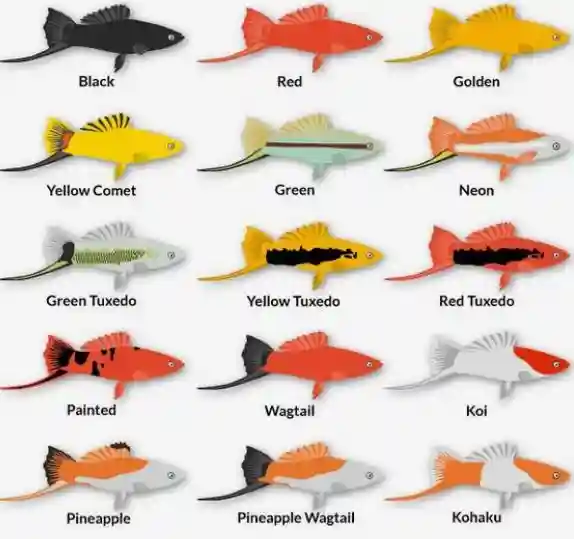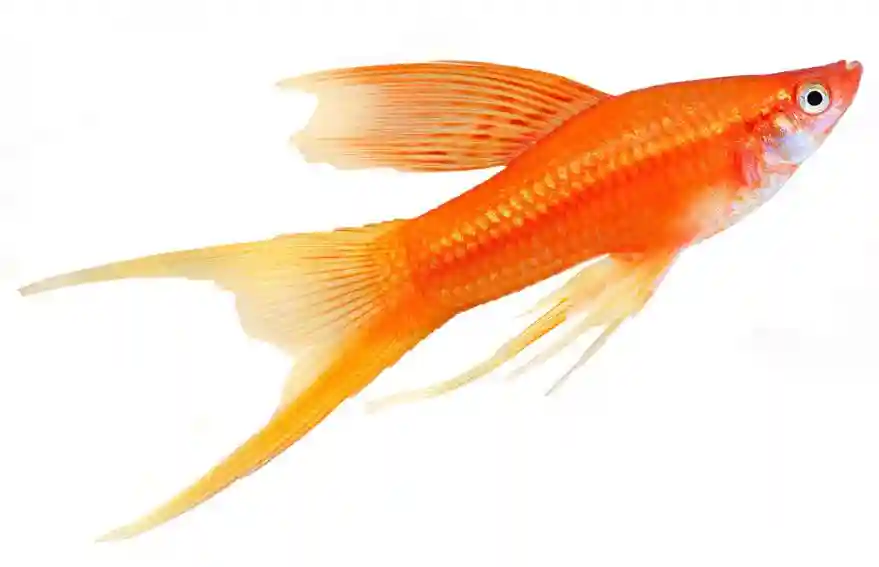Hello Everyone! Swordtail fish are one of the most popular fish for aquarium lovers. There are many types and varieties of swordtail fish. When it comes to adding vibrant colors and lively movement to your aquarium, swordtail fish are an excellent choice. It is known for its elegant swords-like tails. These freshwater fish species belong to the Poeciliidae family. In this article, we will explore the captivating world of swordtails, covering everything from their origin and appearance to their care requirements and breeding habits. Whether you’re an experienced fish keeper or a beginner, this guide will help you understand why swordtails are a popular choice among aquarists worldwide.
The Origin and History of Swordtails
Swordtails (Xiphophorus helleri) are native to Central America, particularly Mexico and Belize. They were first introduced to the aquarium hobby in the early 1900s, and their popularity has only grown since then. The striking appearance of male swordtails, with their elongated lower fins resembling a sword, has made them highly sought after by fish enthusiasts.
The Stunning Varieties of Swordtails
Swordtails come in a wide range of colors and patterns, making them a visually stunning addition to any aquarium. From fiery reds and electric blues to elegant blacks and iridescent greens, there is a swordtail variety to suit every taste. Some popular varieties include the Red Wag Swordtail, Green Swordtail, Pineapple Swordtail, and Black Velvet Swordtail, each with its unique charm.

Here are some of the common types of swordtails:
- Red Swordtail: These swordtails are typically orange to red in coloration, with a distinctive sword-like extension on the caudal fin.
- Black Swordtail: Black swordtails have a dark, often black, body coloration with contrasting red or orange markings. They also feature a swordtail extension.
- Pineapple Swordtail: This variation showcases a mottled or marbled pattern on the body, often in shades of black, yellow, and red.
- Marigold Swordtail: Marigold swordtails are characterized by their bright yellow or gold body coloration and a swordtail extension.
- Neon Swordtail: Neon swordtails have striking, vibrant colors, often with a combination of blue, red, and yellow hues.
- Tuxedo Swordtail: Tuxedo Swordtails have a unique color pattern, resembling a tuxedo. They typically have a dark body with a contrasting light-colored area around the midsection.
- Wagtail Swordtail: These Swordtails have a slightly curved or “wagging” swordtail extension, which is shorter and less straight than other types.
- Red Wag Swordtail: Red Wag Swordtails combines the features of the Red Swordtail with a wagging swordtail extension.
- Green Swordtail: Green Swordtails have a predominantly green body coloration, sometimes with red or black markings.
- Albino Swordtail: Albino Swordtails lack pigmentation and have a white or pale pink body with red or orange eyes.
- Hi-Fin Swordtail: Hi-Fin Swordtails have elongated dorsal fins that give them a distinctive appearance.
- Lyretail Swordtail: Lyretail Swordtails have an elongated, lyre-shaped caudal fin that resembles a musical instrument’s shape.
- Wild-Type Swordtail: These Swordtails closely resemble their natural, wild ancestors in terms of coloration and body shape.
Each type of Swordtail offers unique aesthetics and can add vibrant colors and interesting visual appeal to your aquarium.

10 interesting Facts about Swordtail Fish
- Livebearer: Swordtail Fish are livebearers, which means that they give birth to live young fish instead of laying eggs. The female fish can produce up to 80 fry (baby fish) in a single pregnancy.
- Color Varieties: Swordtail Fish come in a wide range of vibrant colors and patterns. From solid red, orange, and yellow to black, green, and multicolored varieties, their stunning appearance makes them popular among fish keepers.
- Sword-like Tail: One of the distinctive characteristics of Swordtail Fish is the long, sword-like extension on the lower part of their tail. It is larger and more prominent in males, making them easily distinguishable from females.
- Peaceful Nature: Given the right conditions, Swordtail Fish are generally peaceful and can be kept with other peaceful fish species. However, during breeding periods, males may become territorial and display aggressive behavior towards other males.
- Omnivorous Eaters: Swordtails have versatile diets and are considered omnivorous. They feed on a combination of vegetable matter, such as algae and aquatic plants, as well as small insects, larvae, and other small aquatic organisms.
- Easy to Breed: Swordtail Fish are relatively easy to breed, making them a popular choice for beginner aquarists interested in breeding fish. With proper care, they can breed regularly, contributing to the growing population within a tank.
- Prefers Schools: Swordtails are social fish and thrive in schools. They should ideally be kept with at least four to six individuals to prevent any individual from becoming stressed or lonely.
- Good Jumpers: Swordtails have a natural jumping ability and can leap out of the water if startled or frightened. Therefore, it is important to keep their aquarium covered to prevent any escapes or injuries.
- Community Tank Compatibility: Swordtail Fish are quite compatible with a wide range of community tank species, including tetras, mollies, platies, and corydoras catfish. However, it’s important to consider their differing requirements when selecting tank mates.
- Varied Habitat: Swordtail Fish are native to regions of Central America and can be found in a variety of habitats, such as rivers, streams, and freshwater ponds. Their adaptability to various water conditions has contributed to their popularity in the aquarium trade.
These are just a few interesting facts about Swordtail Fish, showcasing their unique characteristics, behavior, and care requirements.
Setting Up the Perfect Aquarium for Swordtails
Before bringing swordtails into your aquarium, it’s essential to create a suitable environment for them to thrive. These fish are relatively hardy, but providing the right conditions will enhance their health and vitality. A well-maintained aquarium with live plants, hiding spots, and ample swimming space will make your swordtails feel at home.
Feeding Your Swordtails
Swordtail fishes are omnivores, meaning they enjoy a varied diet. In the wild, they feed on algae, small insects, and plant matter. In captivity, they readily accept high-quality commercial flake or pellet food. To enhance their diet, consider supplementing with frozen or live foods such as brine shrimp, daphnia, or bloodworms. Providing a balanced diet is key to maintaining their vibrant colors and overall well-being.
- Varied Diet: Swordtails are omnivorous fish, so offer a diverse diet to meet their nutritional needs.
- High-Quality Pellets: Start with a high-quality commercial fish pellet as the staple of their diet. Look for ones designed for tropical fish.
- Live and Frozen Foods: Incorporate live or frozen foods like brine shrimp, daphnia, and bloodworms for added protein and variety.
- Vegetables: Include blanched vegetables like spinach, peas, and zucchini to provide fiber and nutrients.
- Spirulina-based Foods: Consider adding spirulina-based flakes or pellets to support their herbivorous tendencies.
- Frequency: Feed small amounts 2-3 times a day, only what they can consume in a few minutes, to avoid overfeeding.
- Avoid Overfeeding: Overfeeding can lead to health issues and water quality problems. Monitor their eating habits closely.
- Supplements: Occasionally, offer supplements like vitamin-enriched flakes or live foods to enhance their diet.
- Fast Days: Provide one fasting day per week to allow their digestive systems to rest.
- Water Quality: Proper filtration and regular water changes are crucial for maintaining a healthy environment for your swordtails to thrive.
- Observe Behavior: Pay attention to their behavior and adjust their diet accordingly if they show signs of malnutrition or obesity.
- Feed Appropriate Sizes: Ensure the food you offer is appropriately sized for the fish’s mouth and easy to consume.
- Freshness: Store fish food in a cool, dry place to maintain freshness and nutritional value.
- Research: Learn about the specific dietary needs of your Swordtails, as different species may have varying requirements.
- Balance: Strive for a balanced diet that includes protein, vegetables, and supplements to promote overall health and vibrant colors in your Swordtail fish.
Swordtail Behavior and Compatibility
Swordtails are generally peaceful fish, making them suitable for community aquariums. However, it’s essential to choose tankmates carefully to avoid any aggressive interactions. Compatible species include other peaceful community fish like mollies, platies, and peaceful tetras. Avoid keeping them with aggressive or fin-nipping species to prevent stress and injuries.
Swordtail Behavior:
- Active Swimmers: Swordtails are active and agile swimmers, often exploring all levels of the aquarium.
- Schooling Fish: They are generally peaceful and prefer to be kept in groups of 3 or more, which helps reduce stress and aggression.
- Males vs. Females: Male Swordtails can be territorial and may exhibit aggression toward each other, especially if there are limited hiding spots or females.
- Mating Behavior: Males display courting behavior, where they swim near females and flaunt their sword-like tails to impress them.
- Livebearers: Swordtails are livebearers, meaning they give birth to live fry rather than laying eggs. Expect occasional fry in a well-maintained tank.
- Water Parameters: They thrive in a tropical aquarium with a temperature range of 72–82°F (22–28°C) and a pH level between 6.8 and 8.0.
Compatibility:
- Community Fish: Swordtails are compatible with many other community fish species, including tetras, mollies, platies, and peaceful cichlids.
- Avoid Aggressive Species: Avoid keeping them with aggressive or nippy fish that may harass swordtails or damage their fins.
- Similar Water Parameters: Choose tankmates that share similar water parameter requirements to ensure a harmonious environment.
- Females Together: Female Swordtails usually coexist peacefully, but monitor them for any signs of aggression during feeding or breeding.
- Hiding Spots: Provide hiding spots like plants, caves, or driftwood to give fish a refuge if they need a break from social interaction.
- Breeding Tanks: Consider a separate breeding tank if you want to selectively breed swordtails, as males can be aggressive during courtship.
- Tank Size: Ensure a spacious tank to accommodate their active nature and the number of fish in the community. A 20-gallon tank or larger is recommended for a group of swordtails.
- Monitor Behavior: Always observe the behavior of your fish and be ready to separate any individuals showing signs of aggression.
- Quarantine New Fish: Quarantine new fish arrivals to prevent the introduction of diseases or parasites into your main tank.
Swordtail Breeding: A Rewarding Experience
Breeding swordtails can be a fascinating and rewarding experience for aquarium hobbyists. These fish are prolific breeders, and with the right conditions, they can produce fry regularly. To prevent overpopulation, consider having a separate breeding tank or providing ample hiding spots for fry to escape predation in the main tank.
1. Select healthy parent fish: Choose healthy and mature adult swordtails for breeding. Ensure they are free from diseases and parasites.
2. Tank Setup:
- Set up a separate breeding tank to provide a controlled environment. A 10–20-gallon tank is suitable.
- Maintain water conditions with a stable temperature, pH (around 7.0–8.0), and water hardness (moderate to hard).
- Add live or artificial plants for hiding spots, as well as fine-leaved plants for fry to seek refuge.
3. Pairing: Introduce one male to two or more females in the breeding tank. This prevents the male from excessively pursuing a single female.
4. Courtship:
- Male swordtails display elaborate courtship behavior, including flashing their sword-like tails and chasing females.
- Observe the females for signs of readiness, such as a distended abdomen, indicating pregnancy.
5. Pregnancy and Birth:
- Swordtails have a gestation period of approximately 28–40 days.
- Pregnant females develop a noticeable gravid spot near their anal fin, and their abdomen becomes more rounded.
- Monitor the female closely as she approaches her due date.
- Once fry are born, they will be fully formed and independent, swimming actively.
6. Separating Fry:
- When the babies are born, move them to a separate tank or use floating plants in the breeding tank to keep them safe from adult fish. Adult fish won’t typically eat them, keeping the swordtails safe.
- Feed the fry with specialized fry food or powdered flakes designed for small fish.
7. Nutrition: Proper nutrition is crucial for healthy fry growth. Offer a varied diet of crushed flakes, powdered fry food, and live or frozen baby brine shrimp.
8. Water Quality: Maintain excellent water quality with regular water changes to ensure the health and growth of both fry and adults.
9. Growth and Development: As Swordtail fry grows, you’ll notice their vibrant colors and distinctive tails developing.
10. Social Dynamics: Keep an eye on the social dynamics within the breeding tank, as adult fish may need to be separated to prevent aggression.
11. Continuous Cycle: Swordtails are prolific breeders, and the cycle can repeat as long as the conditions are favorable.
Breeding Swordtails not only provides you with the joy of witnessing new life but also helps preserve and maintain these beautiful fish in the hobby.
Common Health Issues and How to Handle Them
Despite their hardiness, swordtails can occasionally face health issues, such as fin rot, ich, and swim bladder disorders. Regular observation and maintenance can help detect early signs of illness. If you notice any abnormalities in your swordtails, it’s important to quarantine them promptly and seek appropriate treatment.
- Ich (White Spot Disease): Swordtails can be susceptible to ich, and the described treatment methods are suitable for them.
- Fin Rot: Swordtails, like other fish, can develop fin rot. Maintaining water quality is crucial to prevent this issue.
- Swim Bladder Disorder: Swordtails can also experience swim bladder issues. The recommended treatment of isolating the affected fish and offering a high-fiber diet applies to them.
- Dropsy: Dropsy can affect Swordtails, and the suggested treatment of isolating the fish and addressing water quality is relevant.
- Fungus: Fungal infections can occur in Swordtails, and the treatment mentioned is appropriate.
- Velvet Disease: Swordtails can contract velvet disease, and the temperature increase and medication advice are applicable.
- Parasitic Infections: Swordtails can suffer from various parasitic infections, and the treatment should be tailored to the specific parasite detected.
- Lethargy and Loss of Appetite: These symptoms can indicate various issues in Swordtails, and the advice to check water parameters and diet applies.
- Hole-in-the-Head Disease (Hexamita): Swordtails can be vulnerable to this condition, and the suggested treatment aligns with their needs.
- Stress: Swordtails can experience stress, and the guidance to identify and address stressors is relevant.
How many swordtails should be kept together?
Ideally, when keeping swordtails in an aquarium, it’s best to have a balanced ratio of males to females. For every one male swordtail, you should have at least two to three female swordtails. This helps reduce aggression among males and provides a more harmonious environment. Keeping a group of swordtails with this male-to-female ratio ensures a healthier and happier community of fish.
Are swordtails good fish?
Yes, swordtails are considered good fish for both experienced and beginner aquarium hobbyists. They are relatively hardy and adaptable, making them easier to care for compared to some other fish species. Their stunning colors and elegant sword-like tails add beauty to any aquarium, making them a popular choice among fish enthusiasts. Additionally, swordtails are generally peaceful, making them suitable for community tanks with other compatible fish species.
Can swordtails live with other fish?
Yes, swordtails can live with other fish in a community aquarium, provided that the tankmates are chosen carefully. Swordtails are generally peaceful and can coexist with other peaceful community fish. Good tankmates for swordtails include mollies, platies, guppies, peaceful tetras, and certain species of catfish. It’s essential to avoid keeping them with aggressive or fin-nipping fish, as this can lead to stress and potential harm to the swordtails.
What fish eats swordtails?
Other fish in a community aquarium usually don’t eat swordtails. As mentioned earlier, they are peaceful and can live harmoniously with other compatible species. However, larger and more aggressive fish might pose a threat to swordtails, especially if they are small in size. It’s vital to avoid keeping swordtails with aggressive predators that might see them as prey. Providing ample hiding spots and a well-structured aquarium can help protect the swordtails from potential threats.
Conclusion
Swordtail fish are a good choice for both experienced and newbie aquarium enthusiasts. Their vibrant colors, peaceful nature, and easy-to-care-for attributes make them an ideal addition to any community tank. Remember to create a well-balanced environment, provide a varied diet, and observe their behavior regularly to ensure the health and happiness of your swordtails. So, why wait? Dive into the fascinating world of swordtails and add a splash of color to your aquarium today! Hope you enjoyed this detailed article!
Frequently Asked Questions
How big do swordtails grow?
Swordtails can grow up to 4 to 5 inches in length, with males being slightly smaller than females.
Do swordtails prefer a planted aquarium?
While swordtails can adapt to various tank setups, they appreciate a planted aquarium as it mimics their natural habitat and provides additional hiding spots.
Can I keep multiple male swordtails together?
Keeping multiple male swordtails in the same tank can lead to territorial conflicts. It’s best to have one male for every two or three females to maintain harmony.
How often should I feed my swordtails?
Feed your swordtails small amounts of food two to three times a day. Overfeeding can lead to health problems and water quality issues.
Are swordtails jumpers?
Yes, swordtails are known to be jumpers, so make sure to have a secure aquarium lid to prevent any accidental escapes.
Disclaimer
“As an Amazon Associate, we earn from qualifying purchases where there is no additional cost to you. This is one way to support us.” The products displayed here are well-researched, highly rated by users, and fast-moving.













